- Characterful engine
- Rides and handles well
- Practical interior despite small dimensions
- Expensive
- Interior quality isn't great
- Clumsy DSG at low speeds
Volkswagen was a little slow in quenching Australia’s thirst for SUVs. The big boy Touareg arrived in 2002 and the Tiguan joined the lineup five years later but, while other manufacturers were quick to plug in every SUV gap in their range as quickly as possible, Volkswagen hesitated before venturing into compact SUV territory. Enter the 2020 Volkswagen T-Cross.
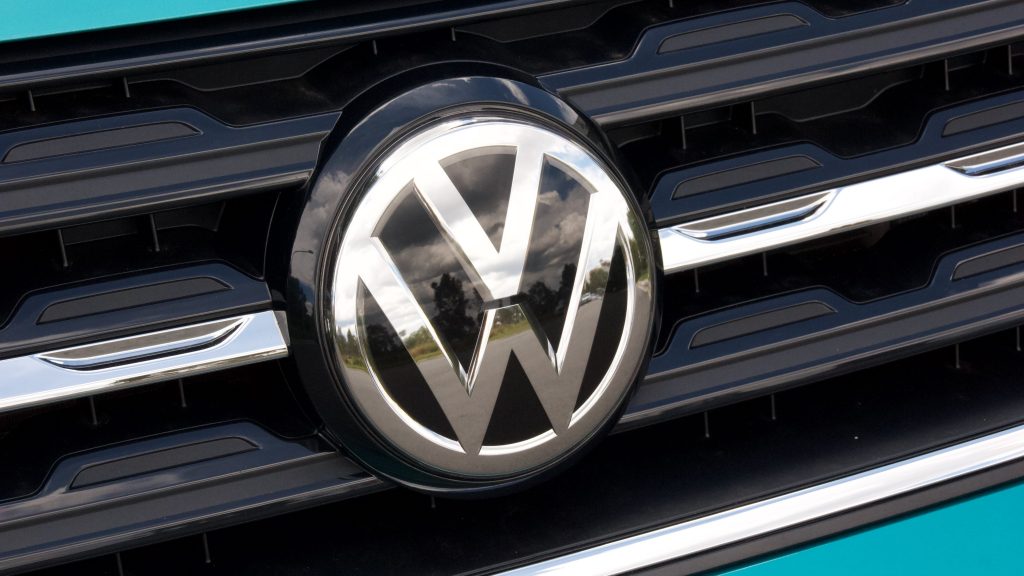
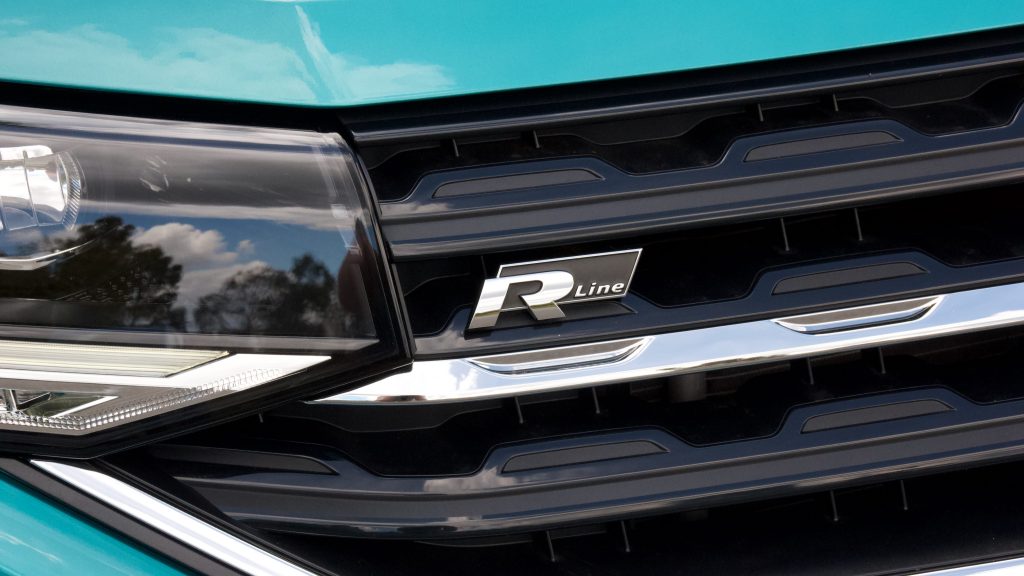
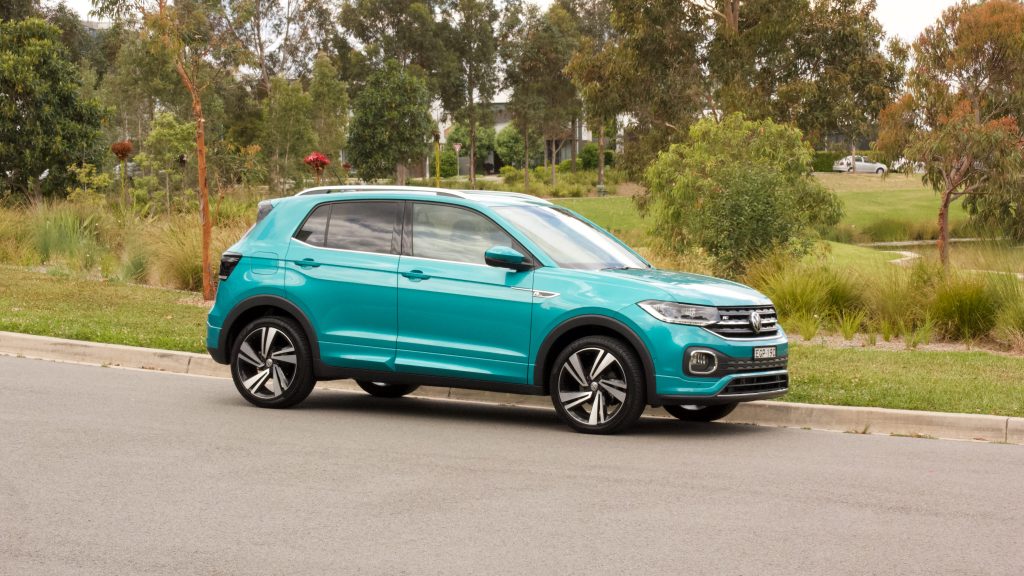
The baby T-Cross and the slightly-bigger-but-still-compact T-Roc both arrived in Australia in 2020 to ensure the German giant doesn’t lose any more ground in one of the most hotly-contested segments locally. We’ll be taking a closer look at the former, which serves as an entry-level offering to Volkswagen’s SUV lineup and faces some pretty serious competition from the likes of the Mazda CX-3, Hyundai Kona, Kia Seltos and its Czech cousin – the Skoda Kamiq. How does the 2020 Volkswagen T-Cross compare to more established rivals? We step behind the wheel to find out.
Price & Specs: 7.0/10
The 2020 Volkswagen T-Cross range offers one 85kW engine across two grades – the 85TSI Life and the 85TSI Style. The T-Cross 85TSI Life kicks off from $27,990 before on-road costs which gets you air-conditioning, a leather steering wheel, cloth upholstery, an 8.0-inch touchscreen with Apple CarPlay and Android Auto, wireless phone charging, four USB ports, a reversing camera, automatic headlights and wipers and an auto-dimming rearview mirror. Safety is taken care of with city-speed autonomous emergency braking (AEB) with pedestrian and cyclist monitoring, rear auto braking, lane-departure assist, driver fatigue detection, rear parking sensors and tyre pressure monitoring. Outside you get 16-inch alloys, halogen lights and black roof rails.
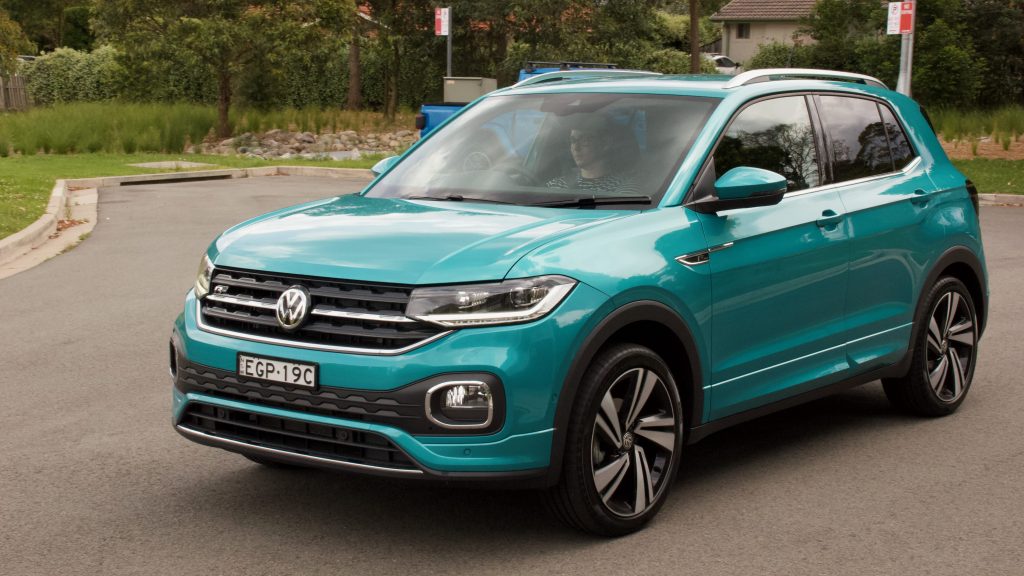
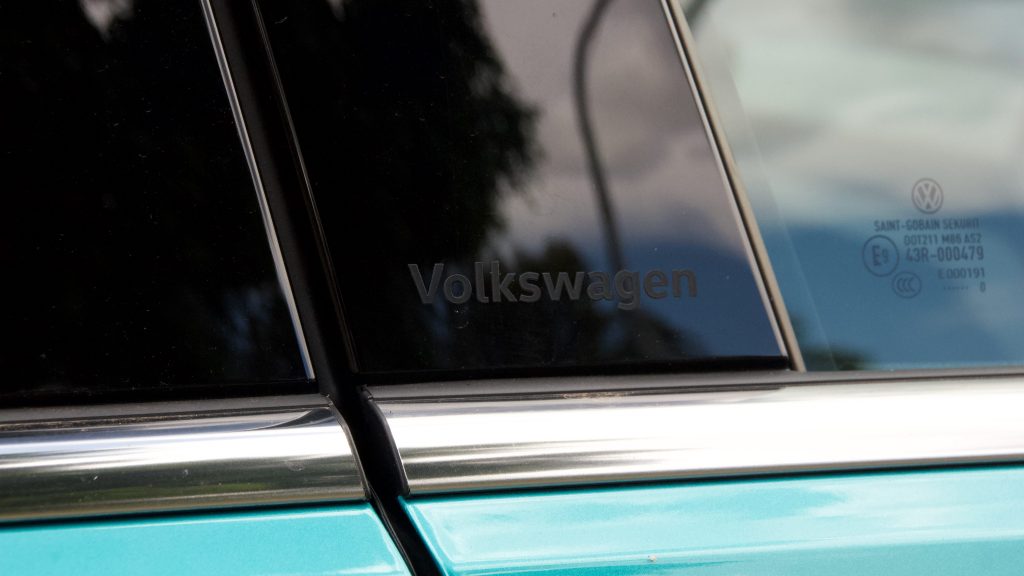
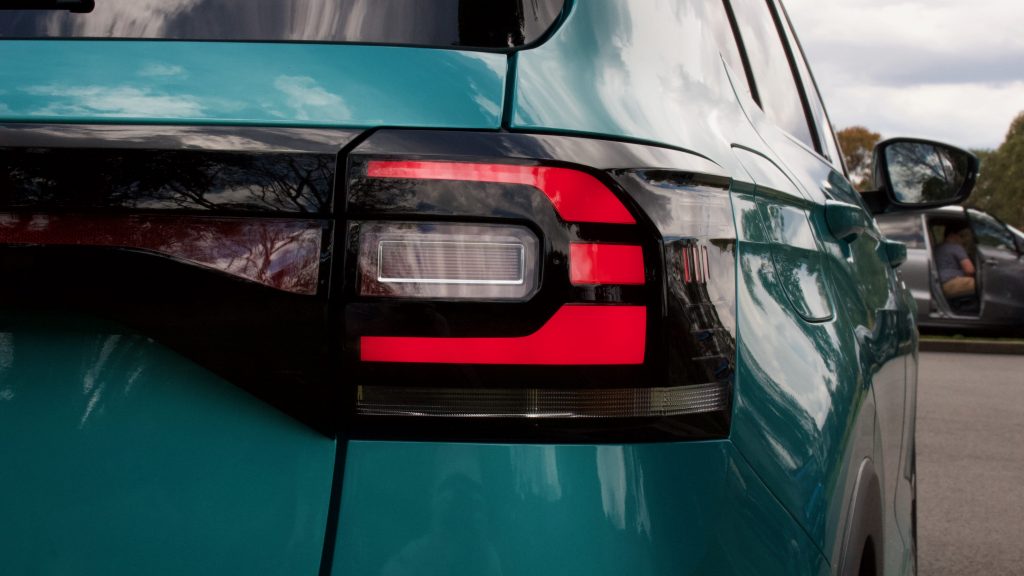
Stepping up to the 85TSI Style adds stylish 17-inch alloys, chrome roof rails, LED headlights with automatic high beam, adaptive cruise control, blind-spot monitoring and rear cross-traffic alert. Inside is treated to dual-zone climate control, a proximity key with push-button start, auto-folding door mirrors, steering wheel gearshift paddles, automatic parking and more bolstered front seats. It’s priced from $30,990 plus on roads – a very worthy spend, in our opinion.
Optionally available are the Sound & Vision Package for $1,900 and the R-Line Package for a further $2,500. The former adds Volkswagen’s excellent digital driver’s display, satellite navigation and a thumping Beats 300W premium audio system and the latter adds 18-inch alloys, R-Line badging and scuff plates, privacy glass, aluminium pedals, a sportier steering wheel and carbon-look cloth upholstery.
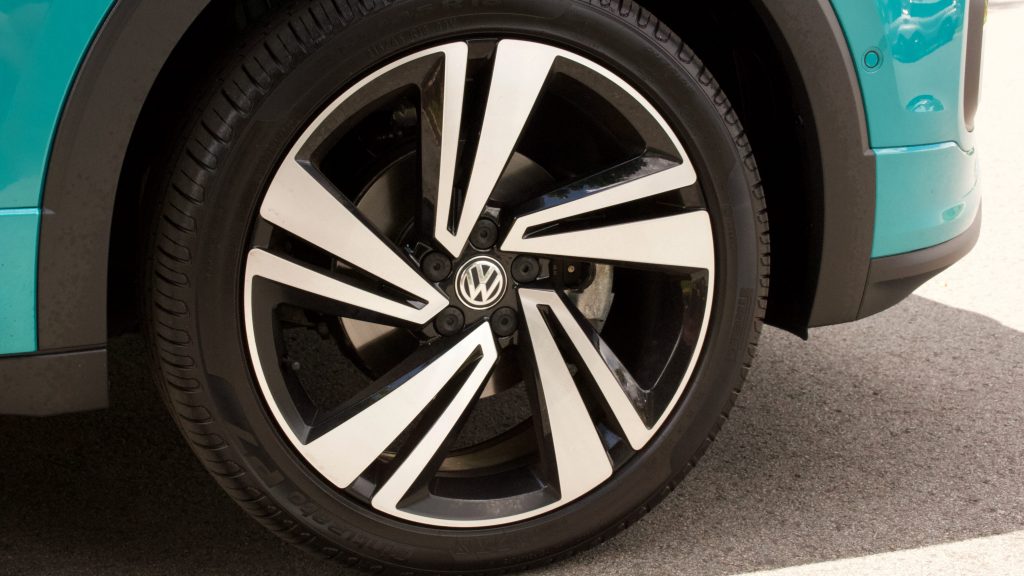
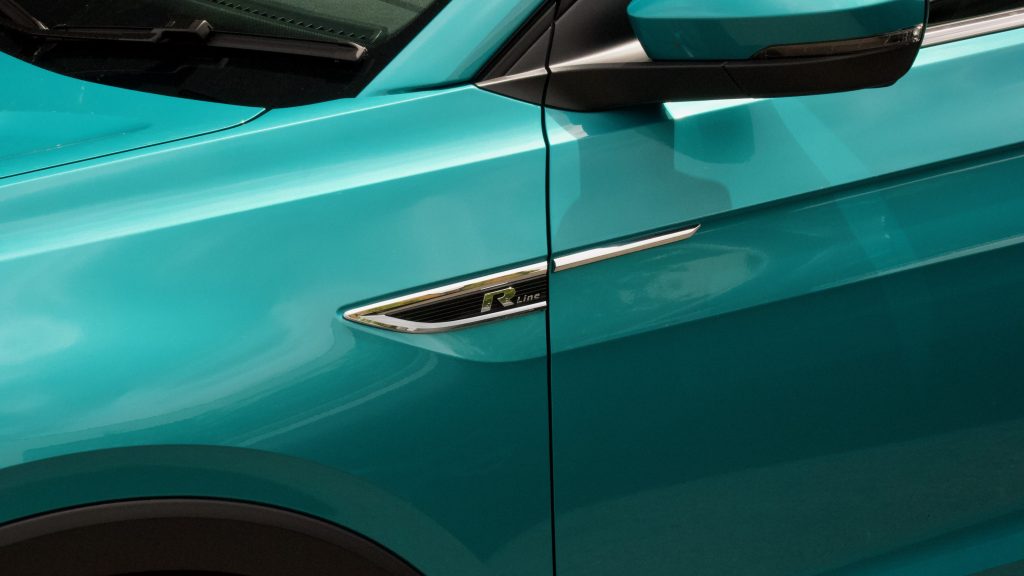
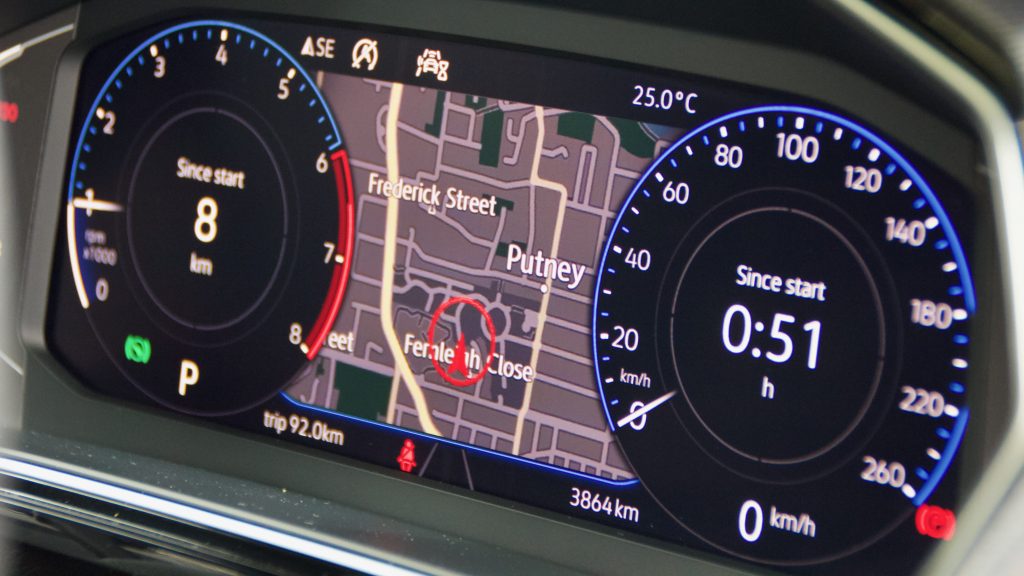
Our T-Cross 85TSI Style was optioned with both packages and finished in the lovely ‘Makena Turquoise’ metallic paint for an additional $800 (all other metallic paints are $600) – meaning this stylish little SUV quickly crept up to $38,346 driveway. A Skoda Kamiq – the T-Cross’ cousin – will match a fully-loaded T-Cross’ powertrain, digital driver’s display, 18-inch wheels and raise it with an automatic tailgate for just $29,990 driveway (or $27,990 driveway if you’re happy to swap cogs yourself). You can also get yourself into a Mazda CX-3 Maxx Sport automatic for $29,490 drive away but it can’t match the T-Cross or Kamiq for technology or practicality.
Performance & Economy: 8.0/10
In Australia the T-Cross is solely powered by a 1.0-litre turbocharged three-cylinder petrol engine paired with a seven-speed dual-clutch transmission sending power to the front wheels. The 1.0-litre engine and 85kW of power might sound tiny (because it is) but the 200Nm of torque is par for the course in the class and is delivered at just 2,000rpm – resulting in the 0 to 100 sprint being completed in a reasonable 10.2 seconds.
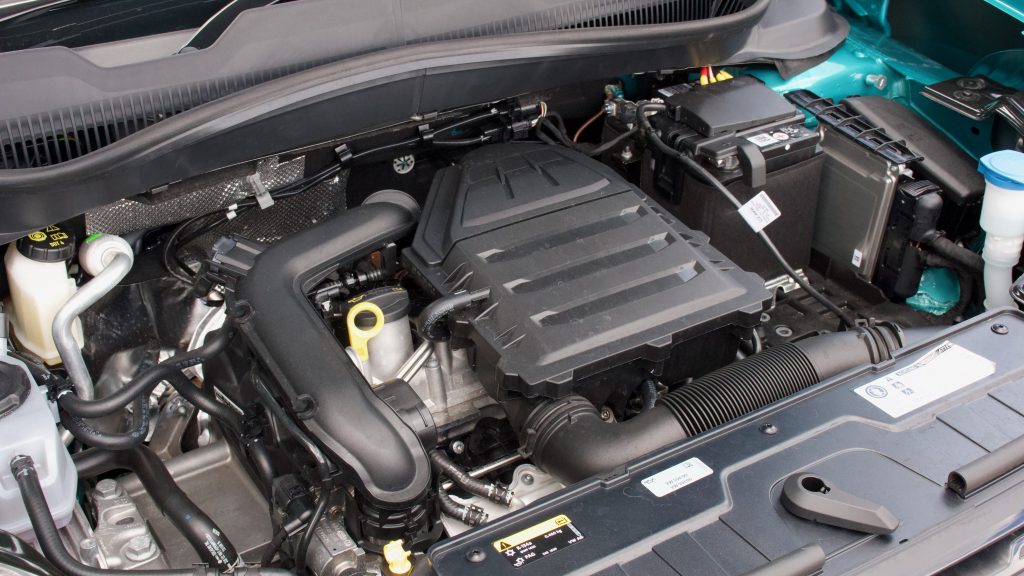
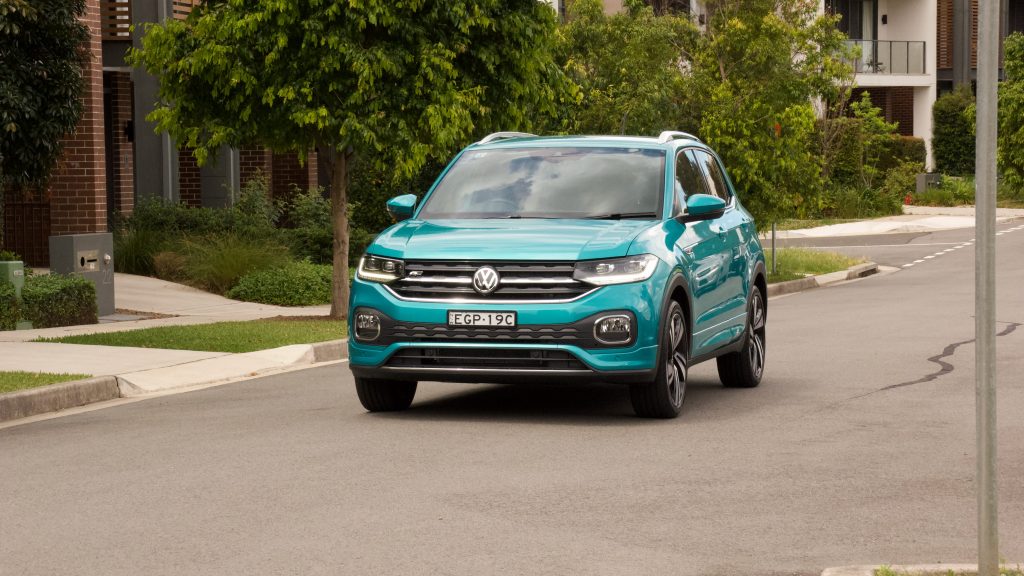
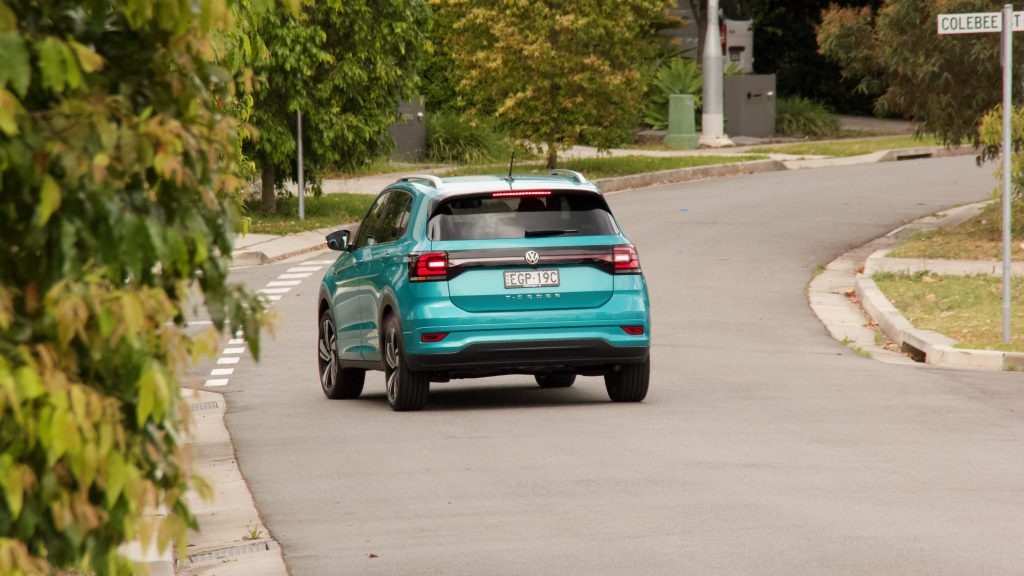
The engine has a characterful thrum that might not be the last word in refinement but it’s far more charming than some annoyingly buzzy four-cylinder units in the segment. The engine and transmission are designed to work together to help the T-Cross achieve the best economy possibly by constantly hunting for the highest gear as quickly as possible and that’s where the mechanical package starts to falter.
“The engine has a characterful thrum that might not be the last word in refinement but it’s far more charming than some annoyingly buzzy four cylinders in the segment.”
Because of the transmission’s tendency to upshift as early as possible in Drive, the acceleration can feel sluggish unless you mash the pedal beyond 60% and at lower revs it can sometimes give off the impression that the engine is about to stall – no doubt the result of its less balanced three-cylinder configuration. The stop/start system kills the engine quickly and quietly (sometimes before you’ve even stopped) and it’ll come back to life almost as quickly, but the time it takes to respond and accelerate is disconcerting. It’s as though the brain that controls the transmission falls asleep when the engine switches off and it takes a moment to reboot when it restarts. The experience is akin to a learner driver who’s embarrassingly stalled at the lights and has to quickly restart the car and zoom off before a series of honks from behind.
“The experience is akin to a learner driver who’s embarrassingly stalled at the lights and has to quickly restart the car and zoom off before a series of honks from behind.”
It’s a shame, because if you turn stop/start off and flick the gear selector into S (for sport) it’s a pleasant little jigger to drive. The torquey engine and otherwise quick-witted dual clutch means the T-Cross is as comfortable out on the open road as it is in the city. The cost of switching it into sport is that fuel economy does suffer slightly, climbing up to 7.2L/100km versus the claimed combined figure of 5.4L/100km. It’s also worth noting that the T-Cross requires 95RON minimum.
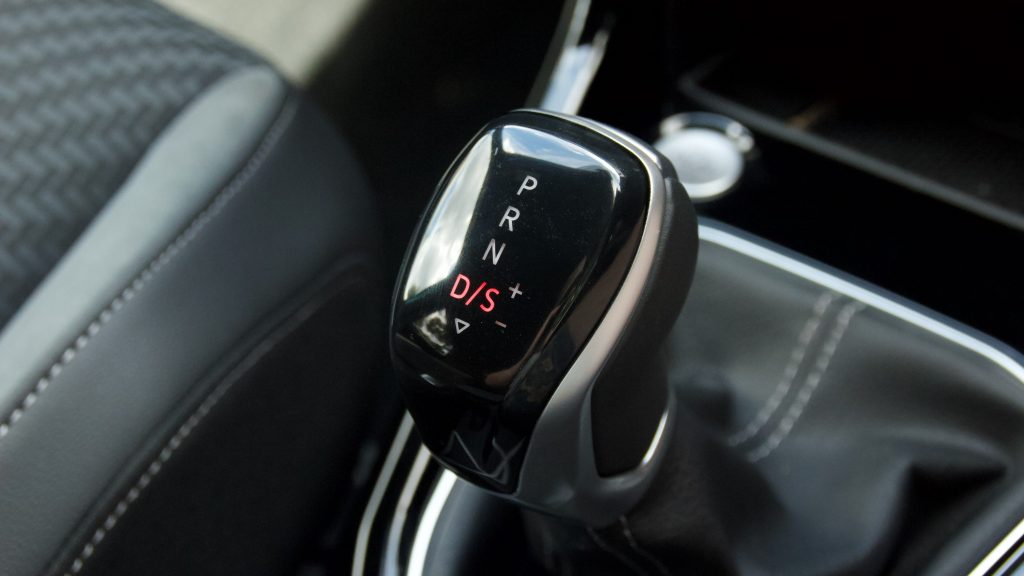
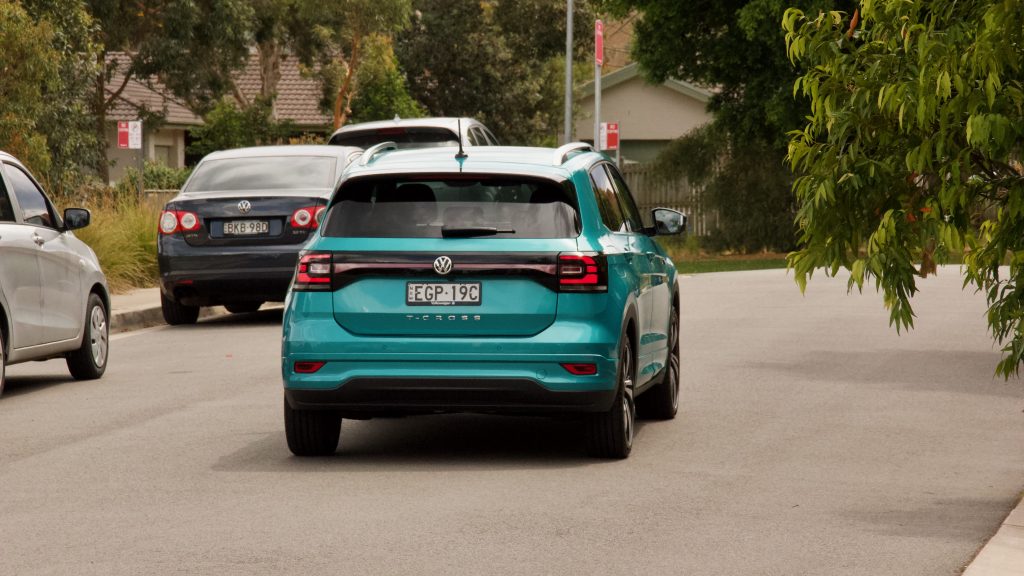
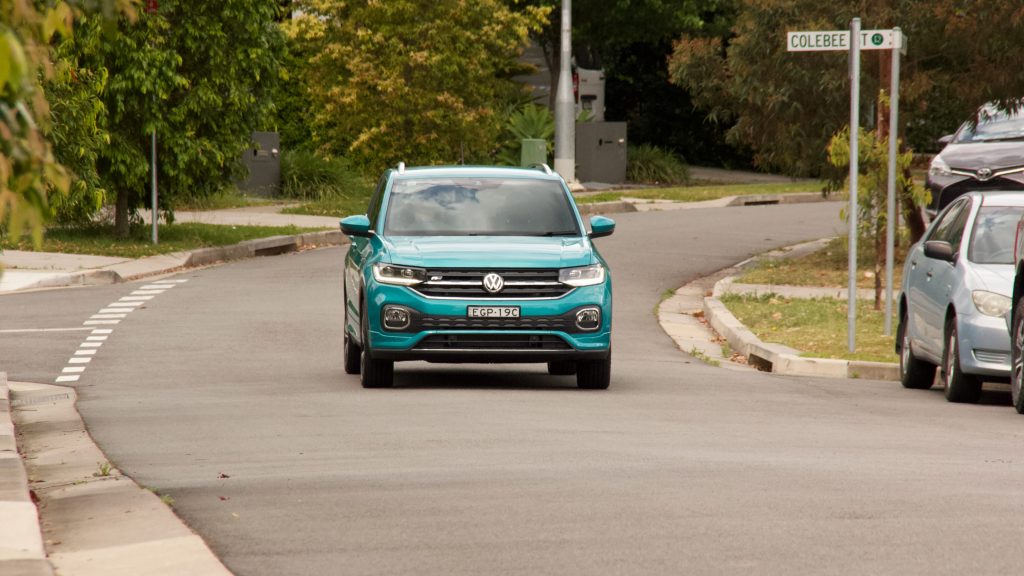
Ultimately, the T-Cross has a good engine that balances economy and performance – as long as you disable stop/start. By comparison, the Mazda CX-3’s 2.0-litre engine offers a convincing 110kW/195Nm and the torque converter automatic means you can simply hop in and drive without leaving you red-faced at the lights. The T-Cross’ twin, the Skoda Kamiq, also offers a manual with the same 85TSI engine, meaning you don’t have to worry about the DSG’s low-speed brain farts.
Ride & Handling: 8.5/10
The Volkswagen T-Cross rides on a stretched version of the MQB-A0 platform that underpins the current Volkswagen Polo. The T-Cross is larger in every dimension and more upright – measuring in at 4,108mm long, 1,760mm wide, 1,583mm tall and riding on a 2,530mm long wheelbase. This translates well for the way the T-Cross rides – giving it that typically Volkswagen ‘comfortably firm’ ride with added suspension travel over your run-of-the-mill hatchback. It does a good job of straddling the line between comfort and handling, with a slightly firmer edge that’s no doubt a result of those larger 18-inch alloys that come with the R-Line package. It feels composed even over uneven surfaces and does its best impression of a bigger car behind the wheel.
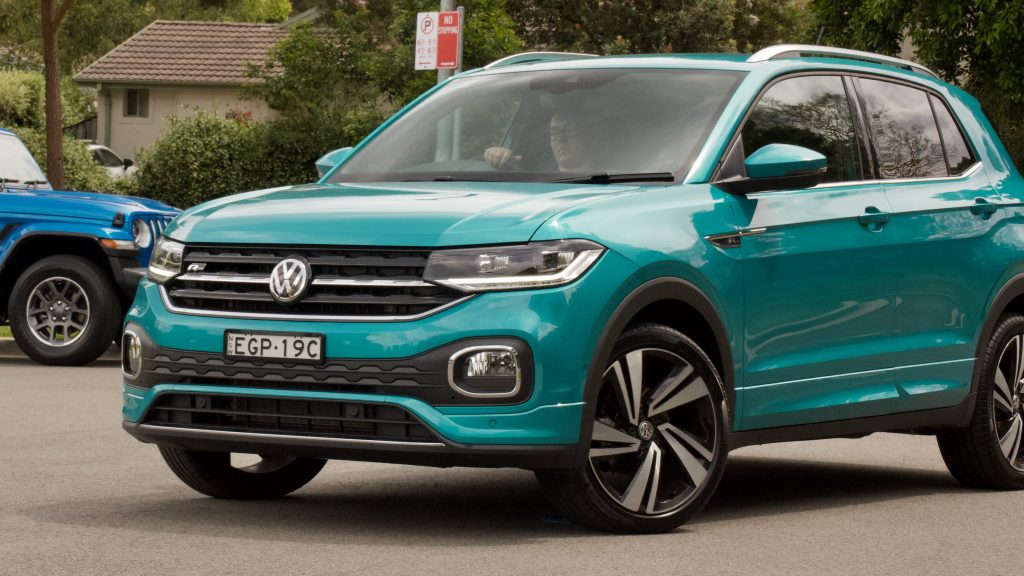
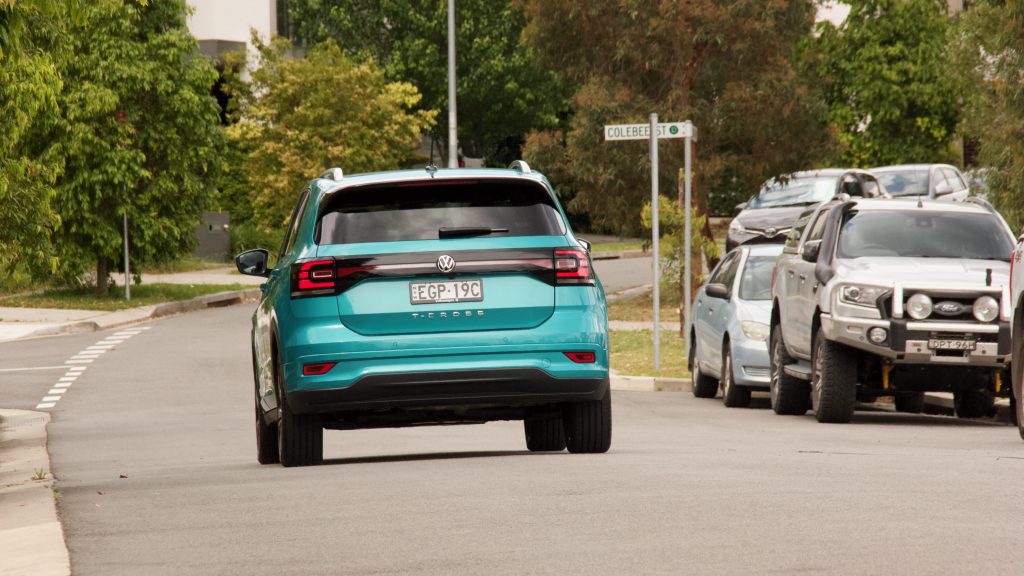
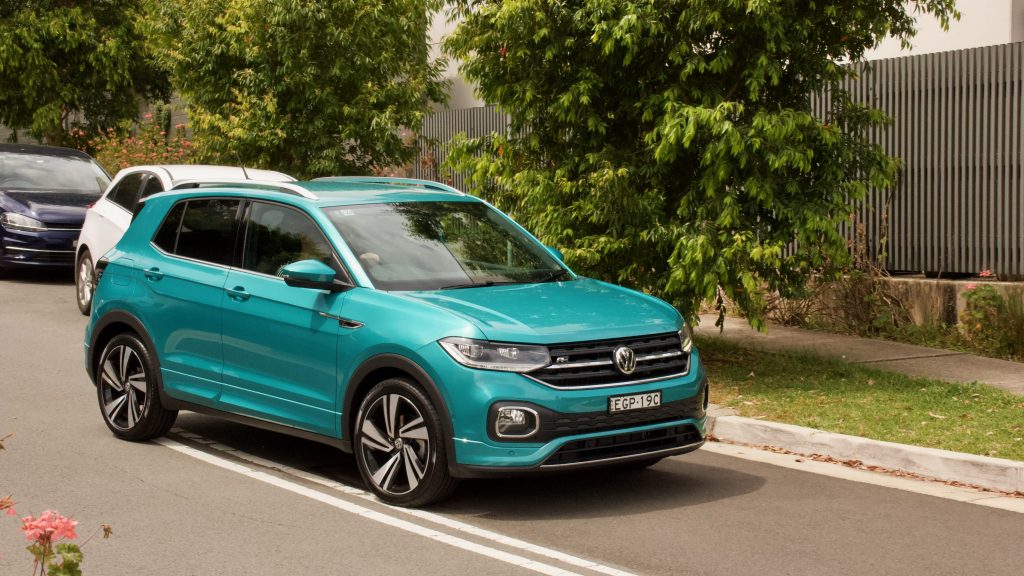
This composure combined with well-weighted steering – which is light enough to make carparks easy work but direct enough to feel stable at speed – inspires confidence. Add the charming three-cylinder engine into the equation and it’s a lot of fun for a small SUV.
“It feels composed even over uneven surfaces and does its best impression of a bigger car behind the wheel.”
Just don’t go racing to the shops too quickly as the tall and skinny body means there is a fair amount of body roll. Cornering with any kind of tenacity also reveals that larger bumps are quick to unsettle the little T-Cross, especially mid-corner hits that see the backend skip out ever so slightly – a tell-tale sign of the torsion rear suspension. Then again, torsion is the standard for the segment unless you go for all-wheel drive rivals like the Hyundai Kona with the 1.6-litre turbocharged engine. A Mazda CX-3 is still the pick for enthusiastic driving.
Interior & Practicality: 8.0/10
The interior is arguably the most important aspect of a compact SUV considering they’re clearly targeted at young trendy folk. The segment is also packed with fierce competition, so the 2020 Volkswagen T-Cross needs to be stylish, practical and laden with technology.
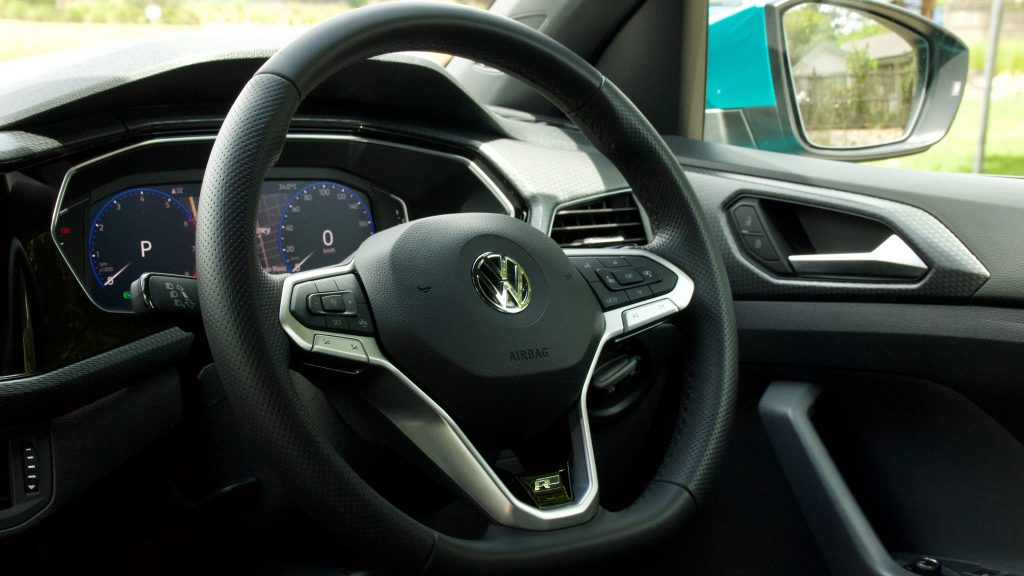
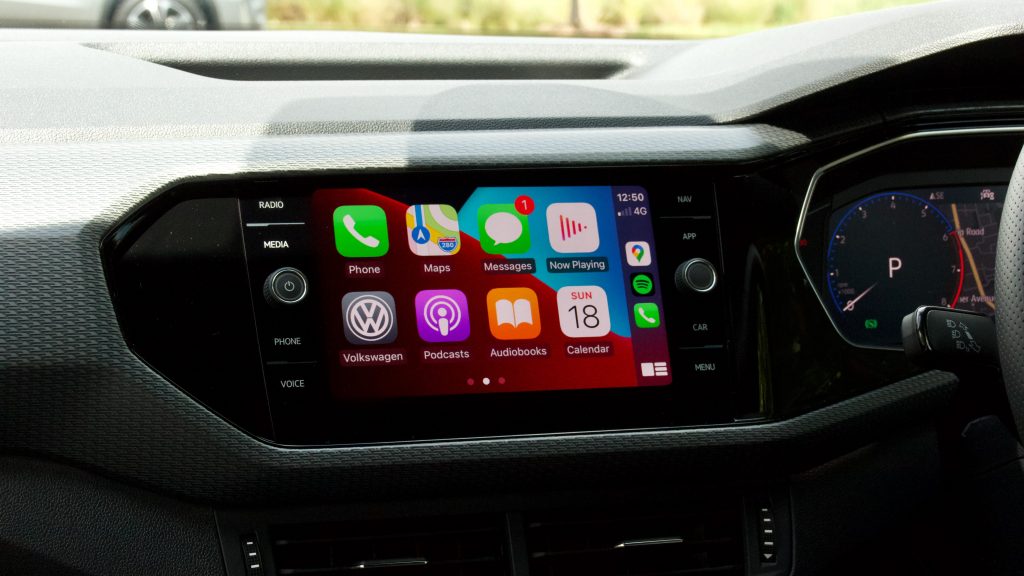
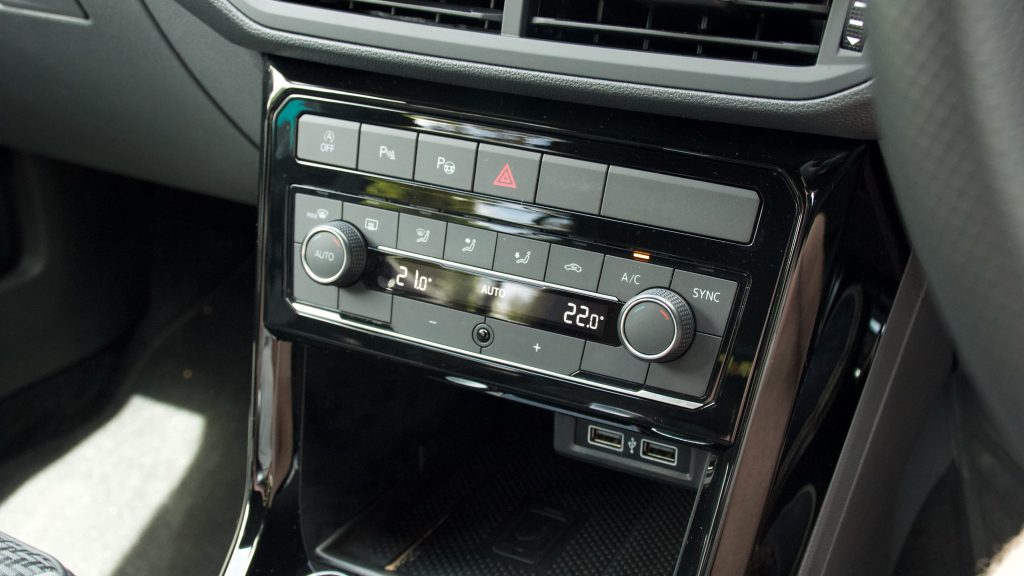
It starts off on the right foot, too – with Volkswagen’s latest active info display (courtesy of the Sound & Vision pack) and a comprehensive, if not cutting edge, infotainment setup. The digital driver’s display is bright, colourful and highly configurable – allowing the driver to switch between traditional dials, a minimalist cockpit, maps and even driver’s aids. This can be further customised from the infotainment screen, allowing you to choose what information is displayed where and how.
“The digital driver’s display is bright, colourful and highly configurable – allowing the driver to switch between traditional dials, a minimalist cockpit, maps and even driver’s aids.”
The 8.0-inch ‘Composition Media’ touchscreen is bright enough and has a reasonably slick user interface, but it isn’t the highest resolution unit or the biggest screen around. While it’s a little disappointing that the Sound & Vision package doesn’t upgrade it to the 9.2-inch ‘Discover Pro’ screen from the Golf 7.5, though at least it adds built-in navigation. It’s also quick to respond to inputs, comes with Apple CarPlay and Android Auto and has a few little party tricks – like a fuel economy coach and a proximity sensor for the touchscreen. And if that doesn’t impress your friends then turn up the impressive 300W Beats sound system: that’ll be sure to knock their socks off.
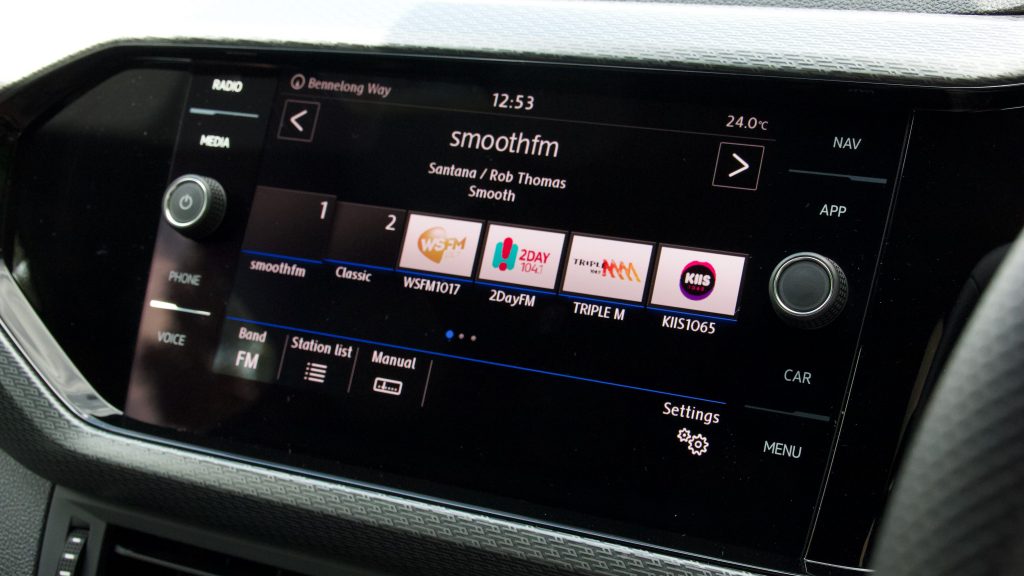
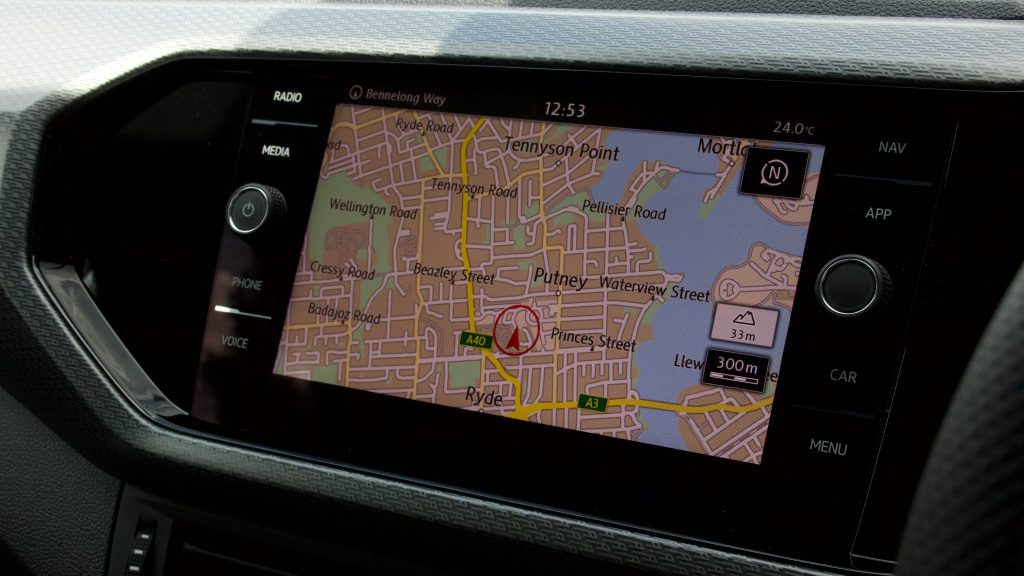
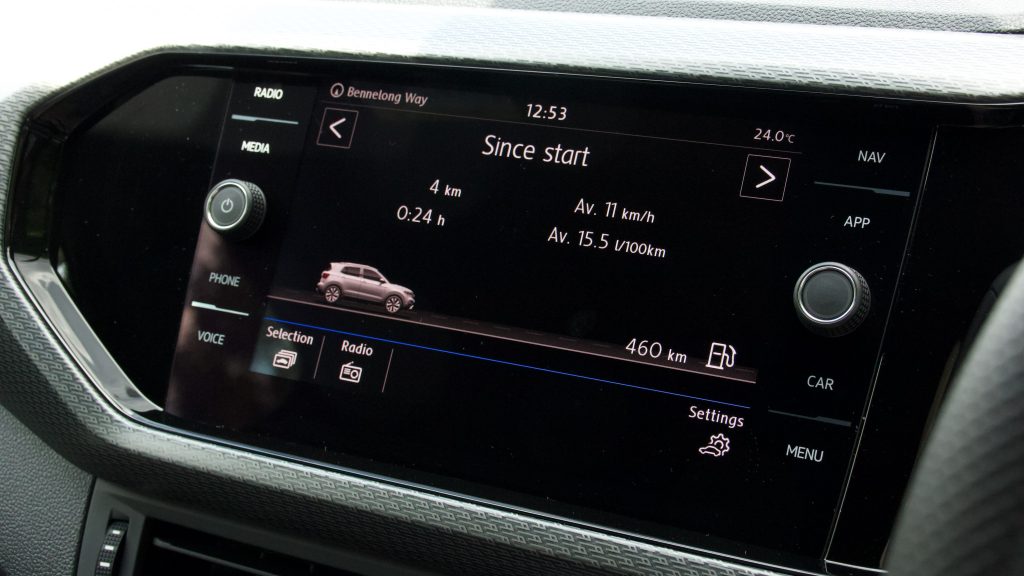
Less impressive is the cabin quality. The design itself isn’t bad – it errs on the plain side of Germanic restraint but has enough contrasting surfaces and details to keep it from being dull. The materials, on the other hand, let the team down. Again, this class isn’t exactly known for its choice of premium interiors, but there isn’t a soft-touch surface in sight. The dash is dominated by a hard carbon-effect insert and upper dash is hollow, hard plastic. It’s a hard pill to swallow when you consider the price of the T-Cross versus the cheaper Polo it’s based on – which happens to have a soft dash. Its Czech cousin also trumps the T-Cross with its soft dash and front door tops – and that’s despite the cheaper entry price.
“…this class isn’t exactly known for its choice of premium interiors, but there isn’t a soft-touch surface in sight.”
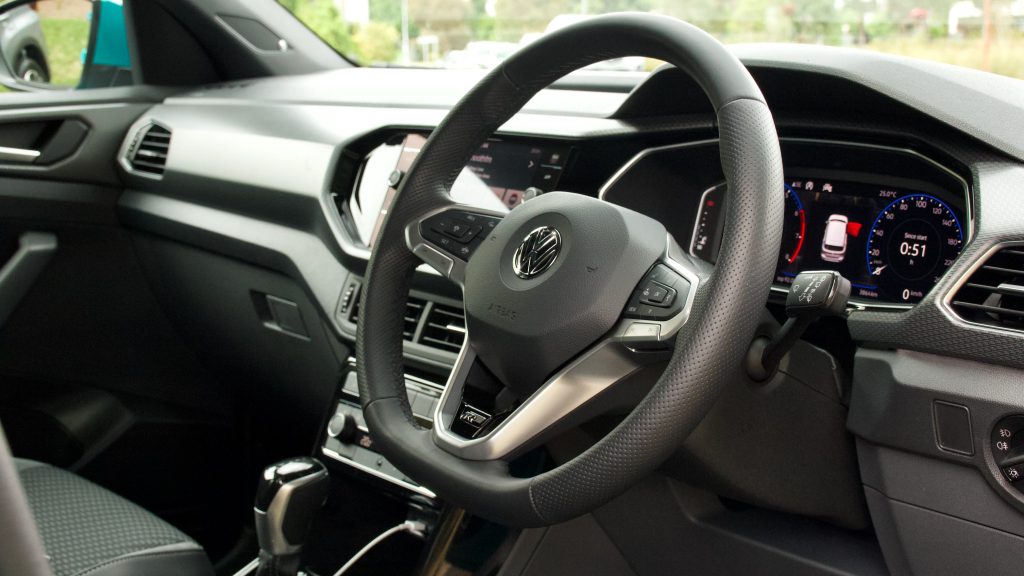
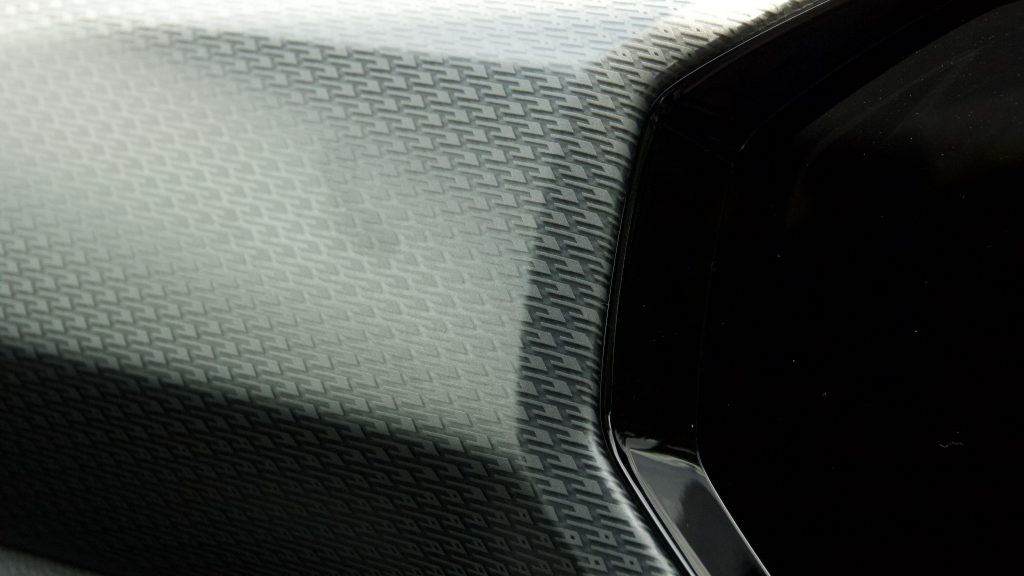
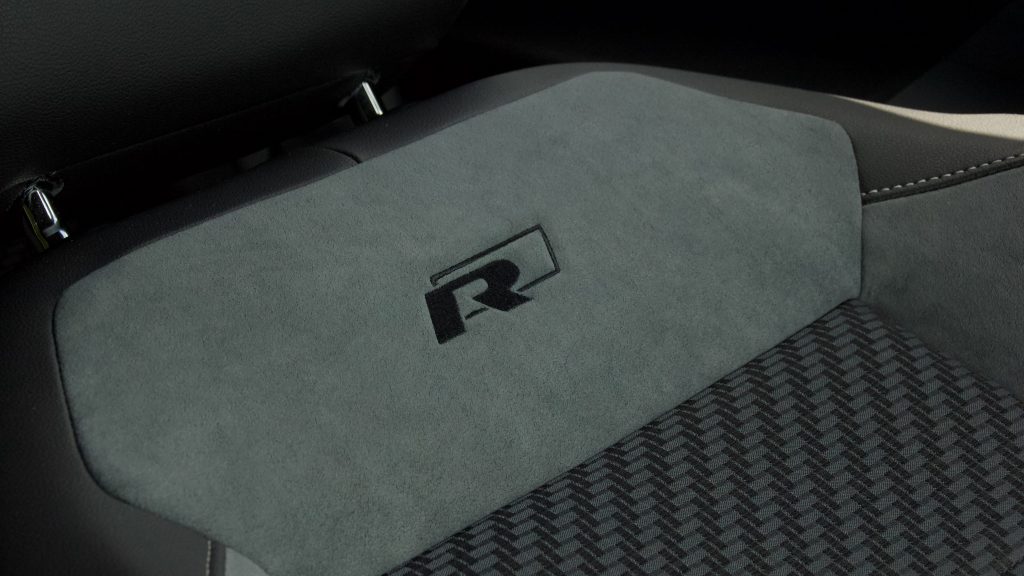
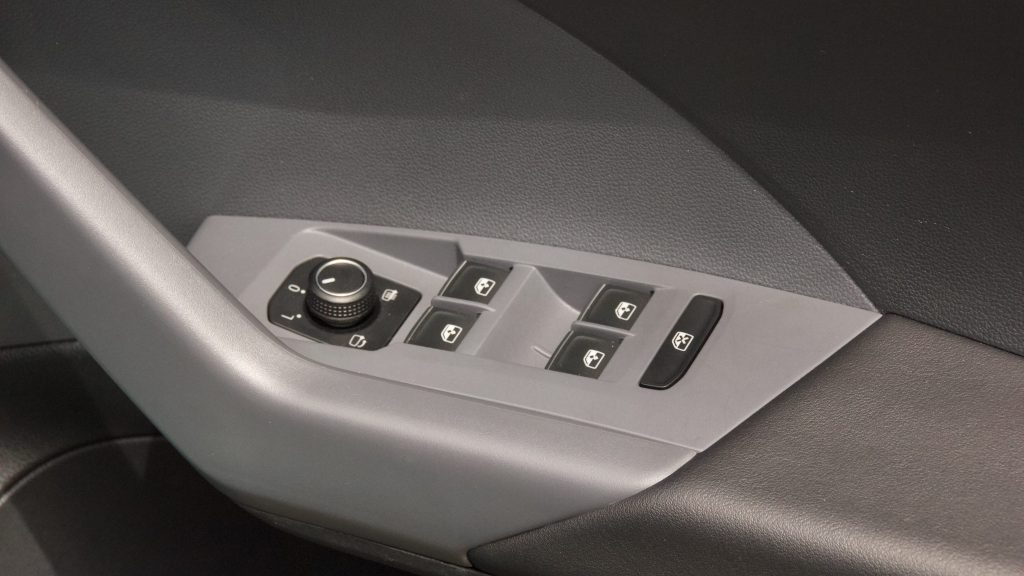
It’s not all bad though. The sports seats wrapped in Alcantara-like cloth courtesy of the R-Line feel high-quality and supremely comfortable. Back-seat passengers are also treated to ample head and legroom for most adults and two USB ports, if not a fold-down armrest or air vents – the latter is again standard on the Kamiq, though no other small SUV. The rear bench slides to allow for more cargo (making for a 415L of space) or more precious cargo (reducing the boot to 385L) – depending on your preference. It is also worth noting that opting for the Sound & Vision pack does mean losing the dual-level floor to a subwoofer.
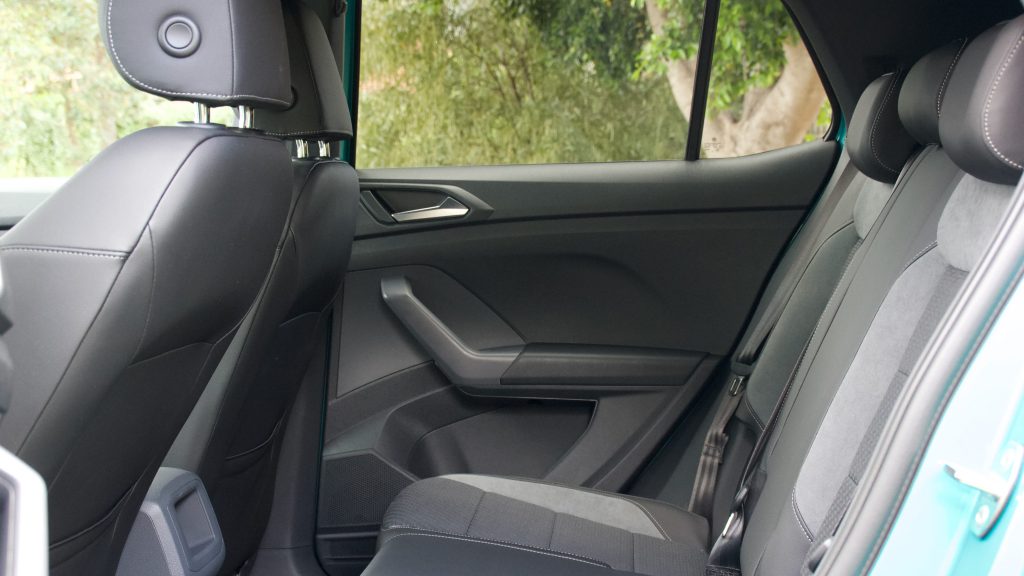
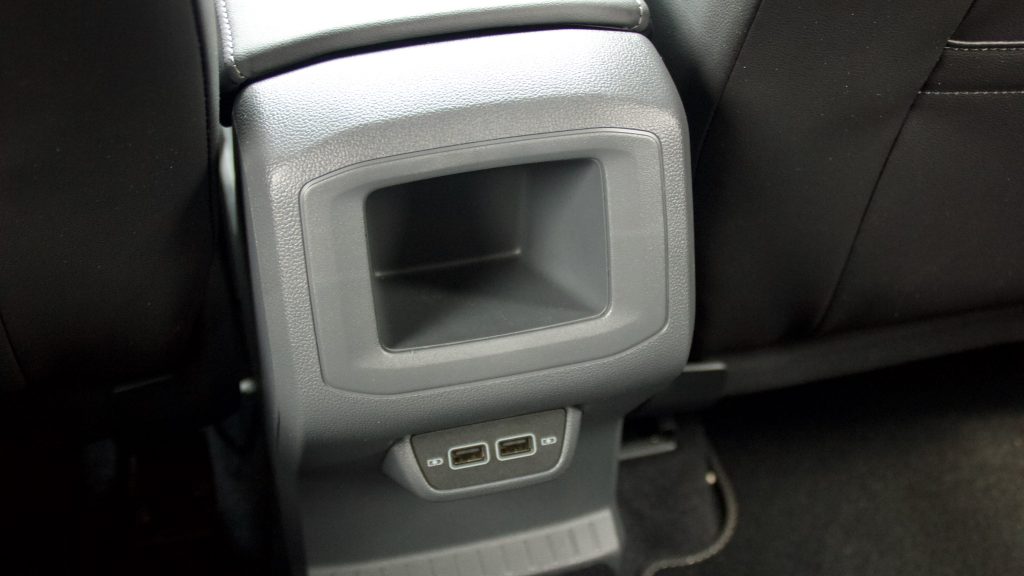
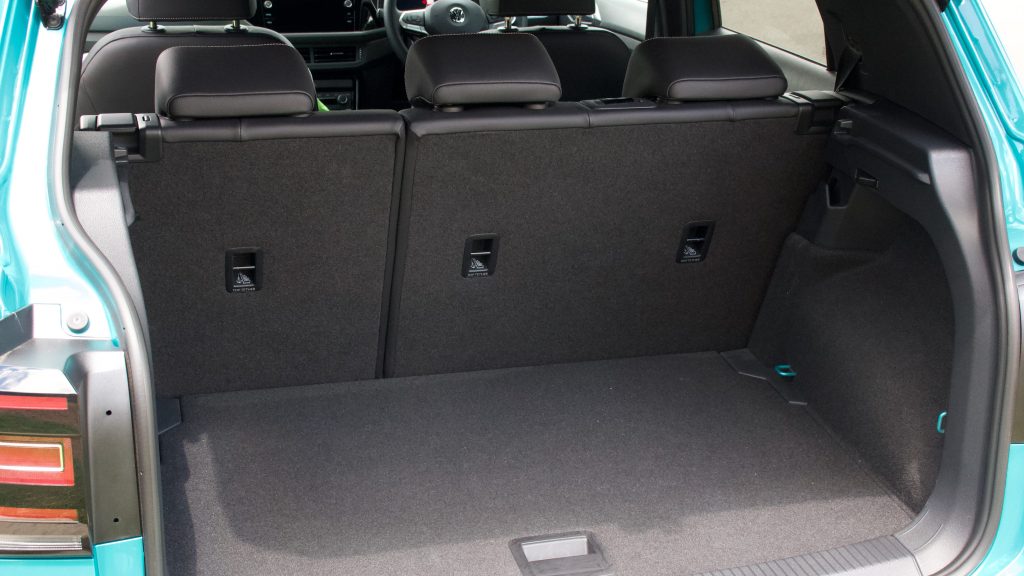
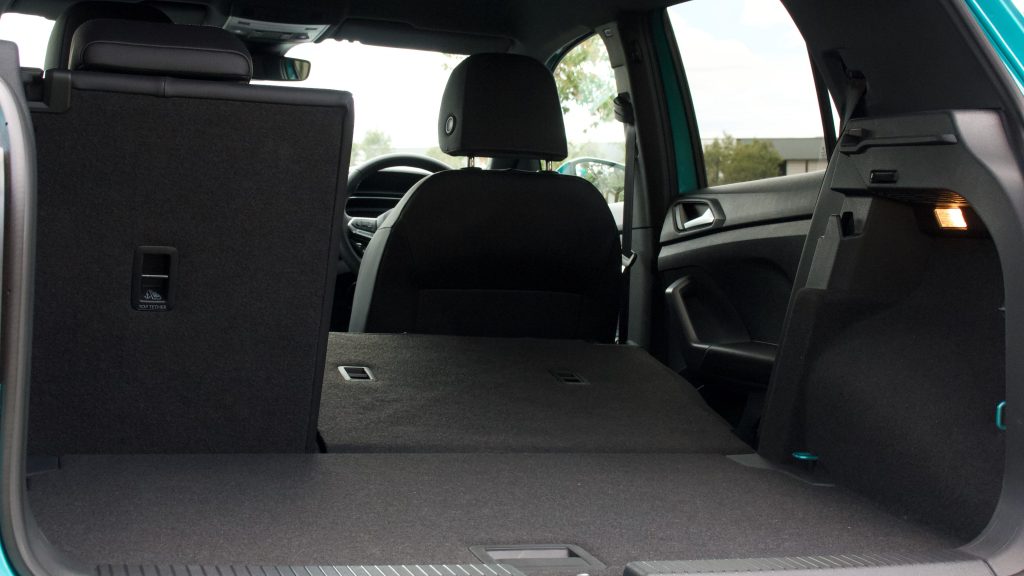
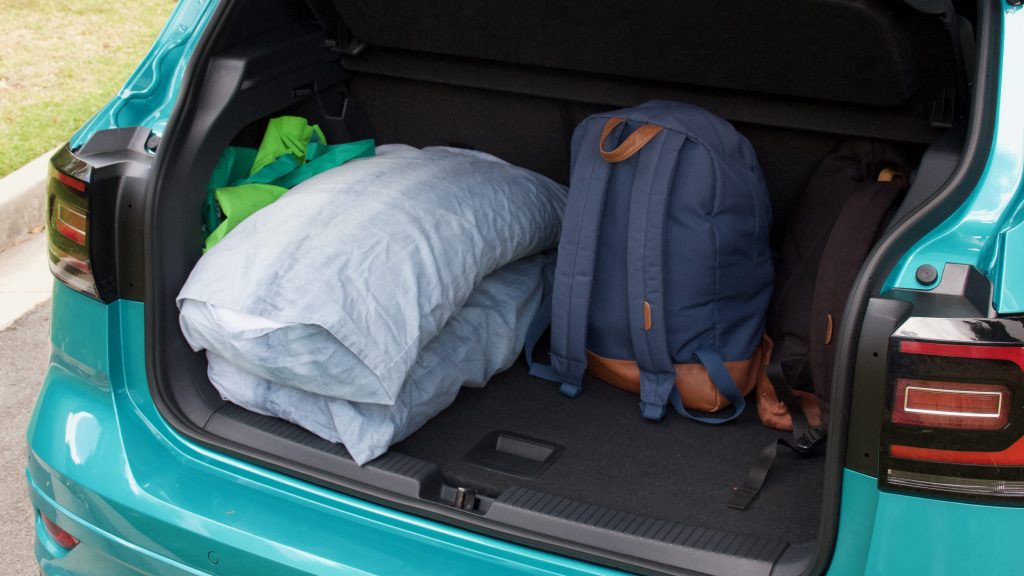
Regardless of whether you opt for the premium audio or not, the T-Cross’ boot and backseat is vastly more commodious than the 2+2 Mazda CX-3 and its tiny 264L boot. It also just trumps the Skoda Kamiq, which swings with its 400L boot that expands to 1,395L with the seats folded down, but misses due to the annoying lip when said seats are folded. The T-Cross’ higher boot floor means you get a flat load area to the tune of 1,281L.
Running Costs & Warranty: 7.5/10
The 2020 Volkswagen T-Cross is covered by a five-year/unlimited km warranty and a year of roadside assistance that is topped up by a year with each scheduled dealership service. Volkswagen offers capped price servicing for up to six years/90,000km and even the choice of a three-year/45,000km or five-year/75,000km pre-paid service plan. The three-year plan will set you back $990 versus $1,215 with normal capped-price servicing, while the five-year plan is $1,800 versus $2,438. It’s a smart option to go for, as they can each save you $225 and $638 respectively when compared to the capped-price service cost.
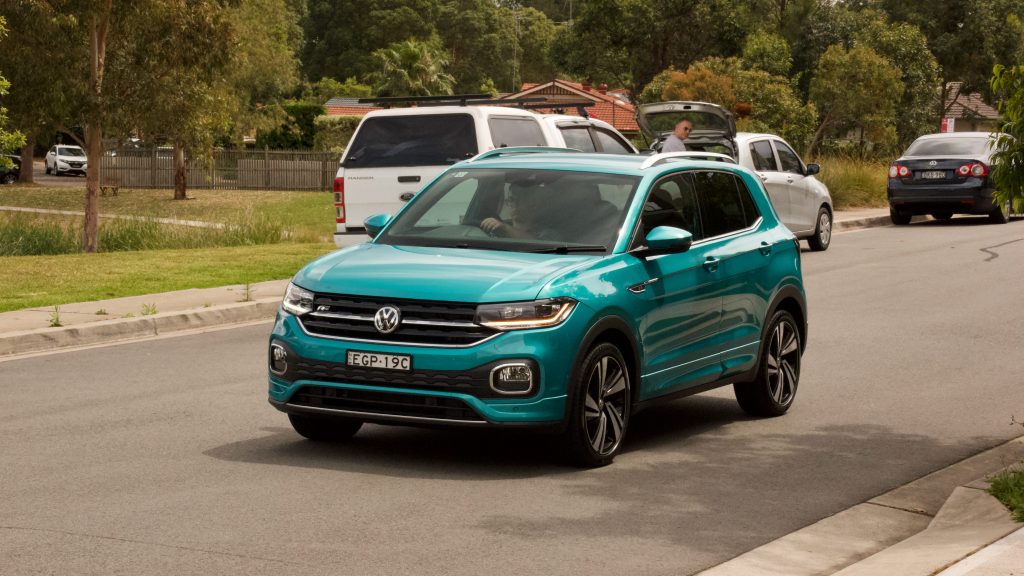
The Kamiq once again plays the value card against the T-Cross – costing $1,124 over three years/45,000km or $2,198 over five years/75,000km with normal capped-price servicing. The service packs bring costs down even further as you can get three years for $800 (a $324 saving) and five years for just $1,400 for five (a $798 saving). Despite a more basic mechanical package, the Mazda CX-3 will set you back $1,218 over three years or just 30,000km thanks to Mazda’s short 10,000km service intervals. Food for thought.
2020 Volkswagen T-Cross 85TSI Style DiscoverAuto Rating: 7.8/10
It might have been late to the compact SUV party, but the 2020 Volkswagen T-Cross is an excellent first attempt in a hyper-competitive segment and should definitely be on your shopping list if you’re looking for a stylish, practical and high-tech little SUV. While the low-speed behaviour of the DSG is a slight chink in its armour, the T-Cross’ biggest foible is the value equation – which has been made even more apparent by its arguably more polished and well-equipped Czech cousin.
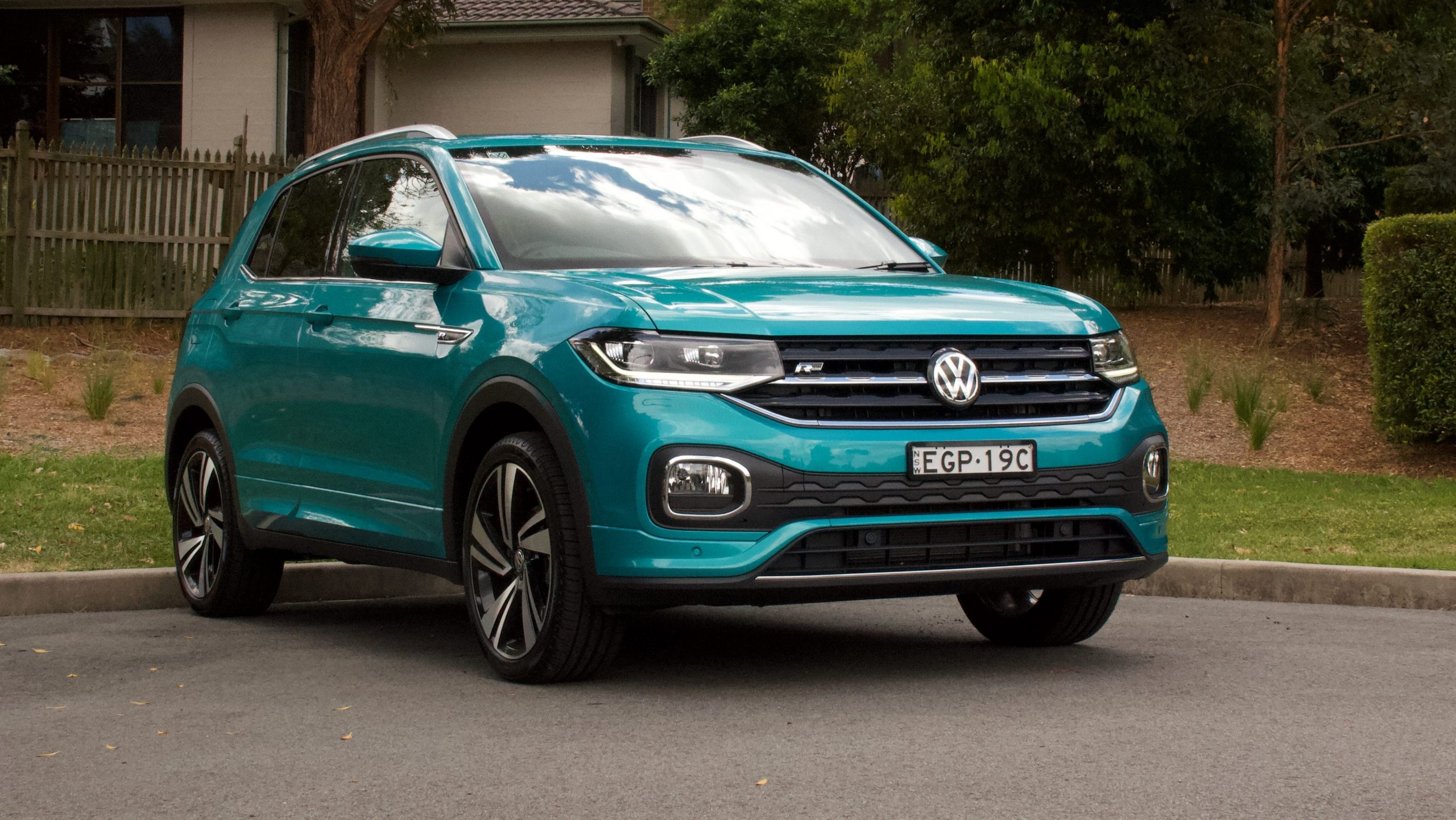
Unless the Volkswagen badge is high on your priority list, we’d suggest taking a closer look at its twin under the skin – the Skoda Kamiq. It packs the same mechanical package and a lot of similar interior tech for vastly less money in an arguably more attractive package. But both are excellent choices in the segment, and deserve your attention.
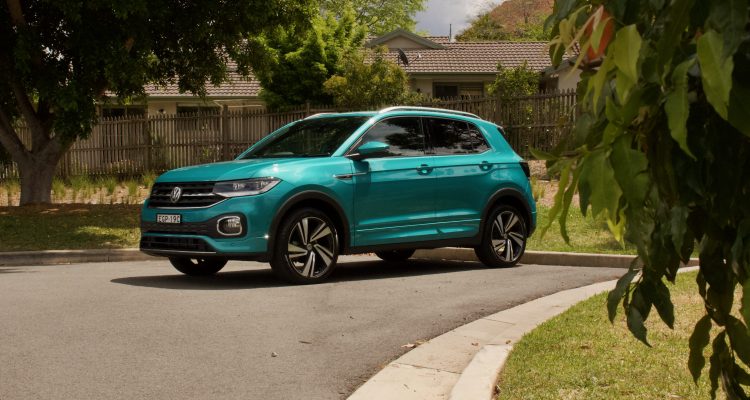
Leave a Reply